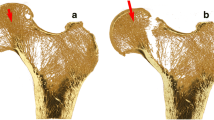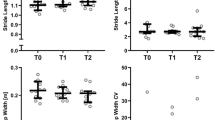Abstract
The most common and severe type of fracture among the elderly is known as a proximal femur fracture. Aging-related bone loss is one of the major contributing factors to increased likelihood of bone fracture. Specific exercises can be used to strain bones and increase bone strength to counter the effects of bone loss. The flexible multibody simulation approach can be used as a non-invasive method for estimating bone strains caused by physical activity. This method was recently used to analyze the strain of locomotion in regard to human femur and tibia leg bones. The current study focuses on strain analysis of the femoral neck. The research test person was a clinically healthy 65-year old Caucasian male. The computed tomography was used to build a geometrically accurate finite element model of the femur with inhomogeneous material properties derived from the voxel data. The anthropometric data was used to model the musculoskeletal system of the test person. The multibody skeletal model was utilized to estimate loading on the femoral neck during walking, which represents a routine daily activity. The flexible multibody simulation results were compared to strains that occurred during a simulated fall onto the greater trochanter of the femur. The fall simulation was made entirely using finite element software. Results from the finite element analysis were compared with the previous study showing that the test person does not belong to the high-risk hip fracture group. Finally, the estimated strains gathered from the walking simulation were compared to the strain values from the simulated fall-down scenario.










Similar content being viewed by others
References
International Osteoporosis Foundation: Osteoporosis in Europe: Indicators of Progress and Outcomes from the European Parliament Osteoporosis Interest Group and European Union Osteoporosis Consultation Panel Meeting (2004). http://www.iofbonehealth.org/download/osteofound/filemanager/publications/pdf/eu-report-2005.pdf
Nieves, J., Bilezikian, J., Lane, J., Einhorn, T., Wang, Y., Steinbuch, M., Cosman, F.: Fragility fractures of the hip and femur: incidence and patient characteristics. Osteoporos. Int. 21(3), 399–408 (2010)
Turner, C.H.: Three rules for bone adaptation to mechanical stimuli. Bone 23, 399–407 (1998)
Arokoski, J.P., Jurvelin, J.S., Väätäinen, U., Helminen, H.J.: Normal and pathological adaptations of articular cartilage to joint loading. Scand. J. Med. Sci. Sports 10(4), 186–198 (2000)
Sharkey, N.A., Hamel, A.J.: A dynamic cadaver model of the stance phase of gait: performance characteristics and kinetic validation. Clin. Biomech. 13(6), 420–433 (1998)
Guterla, C.C., Gardnerc, T.R., Rajanb, V., Ahmadc, C.S., Hunga, C.T., Ateshian, G.A.: Two-dimensional strain fields on the cross section of the human patellofemoral joint under physiological loading. J. Biomech. 42(9), 1275–1281 (2009)
Peterman, M.M., Hamel, A.J., Cavanagh, P.R., Piazza, S.J., Sharkey, N.A.: In vitro modeling of human tibial strains during exercise in micro-gravity. J. Biomech. 34(5), 693–698 (2001)
Lanyon, L.E., Hampson, W.G.J., Goodship, A.E., Shah, J.S.: Bone deformation recorded in vivo from strain gauges attached to the human tibial shaft. Acta Orthop. Scand. 46, 256–268 (1975)
Burr, D.B., Milgrom, C., Fyhrie, D., Forwood, M., Nyska, M., Finestone, A., Hoshaw, S., Saiag, E., Simkin, A.: In vivo measurement of human tibial strains during vigorous activity. Bone 18(5), 405–410 (1996)
Hoshaw, S.J., Fyhrie, D.P., Takano, Y., Burr, D.B., Milgrom, C.: A method suitable for in vivo measurement of bone strain in humans. J. Biomech. 30(5), 521–524 (1997)
Milgrom, C., Finestone, A., Benjoyan, N., Simkin, A., Ekenman, I., Burr, D.B.: Measurement of strain and strain rate developed by jumping exercises in vivo in humans. In: Proceedings of Southern Biomedical Engineering Conference, p. 108 (1998)
Dujovne, A., Wevers, H.W.: Experimental measurements of proximal tibial displacements under load: comparison with FE models. J. Biomech. 22(10), 1006 (1989)
Marom, S.A., Linden, M.J.: Computer aided stress analysis of long bones utilizing computed tomography. J. Biomech. 23(5), 399–404 (1990)
Hof, A.L.: An explicit expression for the moment in multibody systems. J. Biomech. 25(10), 1209–1211 (1992)
Soutas-Little, R.W., Lovasik, K.A., Krueger, M.: Multibody systems analysis of above-knee prostheses to permit rapid gait (racewalking). Adv. Bioeng. 20, 543–546 (1991)
Al Nazer, R., Rantalainen, T., Heinonen, A., Sievänen, H., Mikkola, A.: Flexible multibody simulation approach in the analysis of tibial strain during walking. J. Biomech. 41(5), 1036–1043 (2008)
Al Nazer, R., Klodowski, A., Rantalainen, T., Heinonen, A., Sievänen, H., Mikkola, A.: Analysis of dynamic strains in tibia during human locomotion based on flexible multibody approach integrated with magnetic resonance imaging technique. Multibody Syst. Dyn. 20(4), 287–306 (2008)
Kłodowski, A., Rantalainen, T., Mikkola, A., Heinonen, A., Sievänen, H.: Flexible multibody approach in forward dynamic simulation of locomotive strains in human skeleton with flexible lower body bones. Multibody Syst. Dyn. 25(4), 395–409 (2011)
Orwoll, E., Marshall, L., Nielson, C., Cummings, R., Lapidus, S.J., Cauley, J.A., Ensrud, K., Lane, N., Hoffmann, P.R., Kopperdahl, D.L., Keaveny, T.M.: Finite element analysis of the proximal femur and hip fracture risk in older men. J. Bone Miner. Res. 24(3), 475–483 (2009)
Aamodt, A., Lund-Larsen, J., Eine, J., Andersen, E., Benum, P., Schnell Husby, O.: In vivo measurements show tensile axial strain in the proximal lateral aspect of the human femur. J. Orthop. Res. 15(6), 927–931 (1997)
ANSYS, Inc., ANSYS® Academic Research, Release 11.0, Help System, Element Reference (2007)
Agrawal, O.P., Shabana, A.A.: Dynamic analysis of multibody systems using component modes. Comput. Struct. 21(6), 1303–1312 (1985)
Shabana, A.A.: Dynamics of Multibody Systems, 3rd edn., p. 374. Cambridge University Press, New York (2005)
Wasfy, T.M., Noor, A.K.: Computational strategies for flexible multibody systems. Appl. Mech. Rev. 56(6), 553–613 (2003)
Hounsfield, G.N.: Computerized transverse axial scanning (tomography). Part 1. Description of system. Br. J. Radiol. 46, 1016–1022 (1973)
Rho, J.Y., Hobatho, M.C., Ashman, R.B.: Relations of mechanical properties to density and CT numbers in human bone. Med. Eng. Phys. 17(5), 347–355 (1995)
Espinoza Oriaz, A.A., Deuerling, J.M., Landrigan, M.D., Renaud, E., Roeder, R.K.: Anatomic variation in the elastic anisotropy of cortical bone tissue in the human femur. J. Mech. Behav. Biomed. Mater. 2(3), 255–263 (2009)
Van Rietbergen, B., Odgaard, A., Kabel, J., Huiskes, R.: Direct mechanics assessment of elastic symmetries and properties of trabecular bone architecture. J. Biomech. 29(12), 1653–1657 (1996)
de Bakker, P.M., Manske, S.L., Ebacher, V., Oxland, T.R., Cripton, P.A., Guy, P.: During sideways falls proximal femur fractures initiate in the superolateral cortex: evidence from high-speed video of simulated fractures. J. Biomech. 42(12), 1917–1925 (2009)
Craig, R.R., Bampton, M.C.C.: Coupling of substructures for dynamic analysis. AIAA J. 6(7), 1313–1319 (1968)
MSC.Software, MSC.ADAMS®, Release R3, Help System (2008)
LMS Engineering Innovation. LMS Virtual. Lab (2011). http://www.lmsintl.com/virtuallab
Damsgaard, M., Rasmussen, J., Christensen, S.T., Surma, E., de Zee, M.: Analysis of musculoskeletal systems in the AnyBody modeling system. Simul. Model. Pract. Theory 14(8), 1100–1111 (2006)
Delp, S.L., Anderson, F.C., Arnold, A.S., Loan, P., Habib, A., John, C.T., Guendelman, E., Thelen, D.G.: OpenSim: open-source software to create and analyze dynamic simulations of movement. Biomed. Eng. 54(11), 1940–1950 (2007)
Chao, E., Armiger, R., Yoshida, H., Lim, J., Haraguchi, N.: Virtual interactive musculoskeletal system (VIMS) in orthopaedic research, education and clinical patient care. J. Orthop. Surg. Res. 2(1), 2–21 (2007)
Erdman, A.G., Sandor, G.N.: Kineto-elastodynamics—a review of the state of the art trends. Mech. Mach. Theory 7(1), 19–33 (1972)
Kamman, J.W., Huston, R.L.: Multibody dynamics modeling of variable length cable systems. Multibody Syst. Dyn. 5(3), 211–221 (2001)
Raman-Nair, W., Baddour, R.E.: Three-dimensional dynamics of a flexible marine riser undergoing large elastic deformations. Multibody Syst. Dyn. 10(4), 393–423 (2003)
C. U. Biomechanics Research Group Inc. LifeMOD online user’s manual (2008). http://www.lifemodeler.com/LM_Manual_2008/
Gilchrist, L.A., Winter, D.A.: A two-part, viscoelastic foot model for use in gait simulations. J. Biomech. 29(6), 795–798 (1996)
Wakao, N., Harada, A., Matsui, Y., Takemura, M., Shimokata, H., Mizuno, M., Ito, M., Matsuyama, Y., Ishiguro, N.: The effect of impact direction on the fracture load of osteoporotic proximal femurs. Med. Eng. Phys. 31(9), 1134–1139 (2009)
Crowninshield, R.D., Brand, R.A.: A physiologically based criterion of muscle force prediction in locomotion. J. Biomech. 14(11), 793–801 (1981)
Rantalainen, T., Klodowski, A., Piitulainen, H.: Effect of innervation zones in estimating biceps brachii force-EMG relationship during isometric contraction. J. Electromyogr. Kinesiol. 22(1), 80–87 (2012)
Amarantini, D., Rao, G., Berton, E.: A two-step EMG-and-optimization process to estimate muscle force during dynamic movement. J. Biomech. 43(9), 1827–1830 (2010)
Gordon, C.C., Churchill, T., Clauser, C.E., Bradtmiller, B., McConville, J.T., Tebbets, I., Walker, R.A.: Anthropometric survey of U.S. army personnel, methods and summary statistics (1989)
Dao, T.T., Marin, F., Ho Ba Tho, M.C.: Sensitivity of the anthropometrical and geometrical parameters of the bones and muscles on a musculoskeletal model of the lower limbs. In: 31st Annual International Conference of the IEEE EMBS, Minneapolis, Minnesota, USA, September 2–6, pp. 5251–5254 (2009)
Author information
Authors and Affiliations
Corresponding author
Rights and permissions
About this article
Cite this article
Kłodowski, A., Valkeapää, A. & Mikkola, A. Pilot study on proximal femur strains during locomotion and fall-down scenario. Multibody Syst Dyn 28, 239–256 (2012). https://doi.org/10.1007/s11044-012-9312-0
Received:
Accepted:
Published:
Issue Date:
DOI: https://doi.org/10.1007/s11044-012-9312-0




